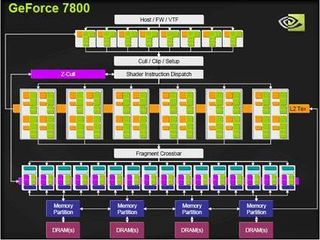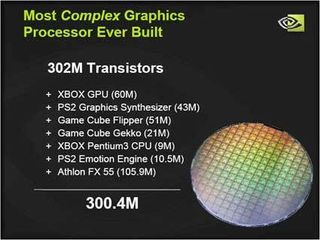24 Pipelines of Power! NVIDIA 7800 GTX
NV Or Not NV? G70 Is The Question
Some had anticipated that this chip was to be called the NV47 - I even heard one journalist comically calling it "NV47" out of spite when looking to ATI's upcoming R520. I was told by NVIDIA that they scrapped the NV47 project; the story is that NVIDIA's engineers were able to deliver a more advanced chip and therefore they decided to skip NV47 all together.
According to Nick Stam, NVIDIA's Director for Technical Marketing, the 7800 GTX is an "entirely different design." But according to what we see in the G70, this might not be true - why would you mothball all of the work that went into the NV47? Secondly, looking at the technical changes, NV47 would be a DirectX9c part with minor enhancements. I guess this is where we must do our best to let you decide what the truth is.

Here is the flow diagram of the 3D process inside the G70.
The GeForce 7800 GTX has 24 pixel pipelines and 8 vertex units operating at a core clock speed of 430 MHz. This is an increase over the GeForce 6's 16 pixel pipelines and 6 vertex shaders of 8 and 2 respectively. Unlike the generous addition to these core components, there was only an increase in clock speed of a mere 30 MHz over the previous generation (400 MHz to 430 MHz). However, weighing in with a whopping 302 million transistors, the GeForce 7800 GTX even breaks the total of the 6800 Ultra by 80 million. NVIDIA put together an interesting slide for us at Editor's Day to show what it would take to equal the computing size of the 7800.

It is hard to comprehend that the number of transistors needed to power an Xbox, PS2, FX-55, and two Game Cubes does not equal the number in G70.
With shaders, there are two functions: instructions and operations (Ops). Instructions are defined as functions that are to be applied to the components of a pixel (RGB or alpha). The shaders then make their calculations in light of these instructions. So you might be asking, "How does the card use these?"
Like the NV40, data hits the vertex shaders first; the manipulated data then goes through the pixel shading pipelines. Lastly it arrives at the Raster Operations (ROP) pipeline and then proceeds onto your screen. During that process you may have noticed that in addition to the extra shading units, the pixel shading units are clustered in groups of four. The pixel pipeline is equipped with FP32 (Floating Point 32 bit) shader units. Working together, these units provide extra efficiency while filtering. In addition, they are able to run at 128 bit floating point throughout the rest of the graphics pipeline (32bpp, 64bpp, and 128bpp natively). Let's take a closer look at how the GeForce 7800 GTX gets even shadier than the 6800 Ultra.
Stay on the Cutting Edge
Join the experts who read Tom's Hardware for the inside track on enthusiast PC tech news — and have for over 25 years. We'll send breaking news and in-depth reviews of CPUs, GPUs, AI, maker hardware and more straight to your inbox.

Current page: NV Or Not NV? G70 Is The Question
Prev Page Introduction Next Page NVIDIA Gets Shady With CineFX 4.0Most Popular

